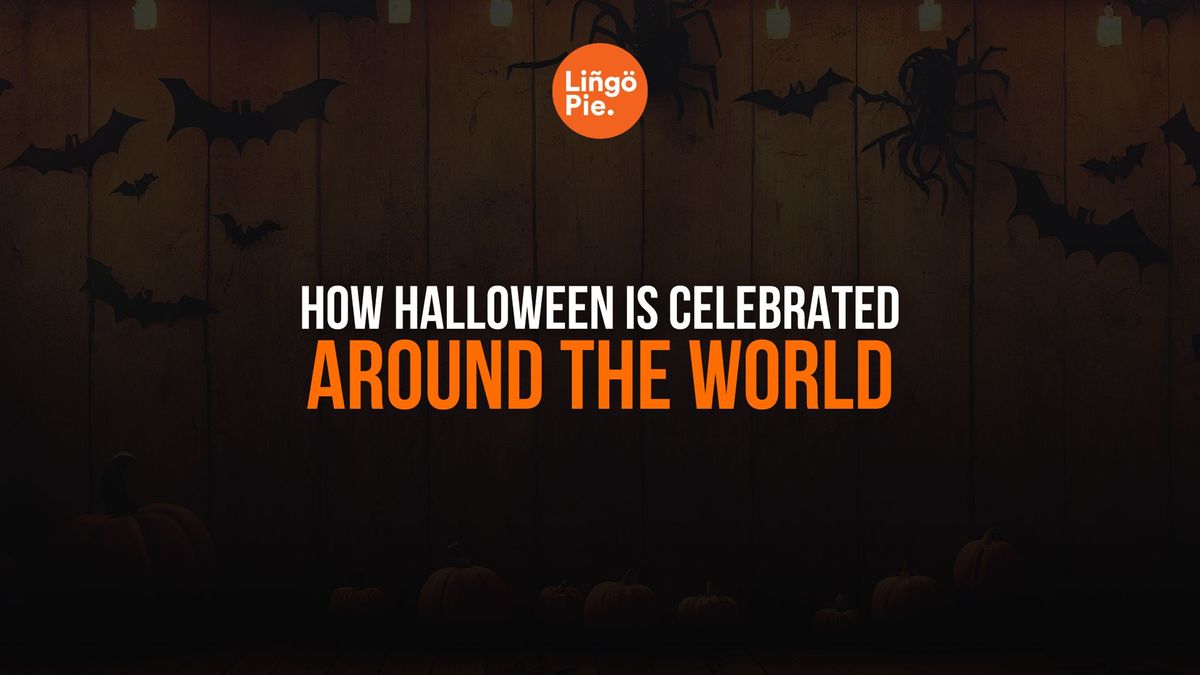With the spookiest night of the year once more upon us, it’s time to have a look at Halloween celebrations around the world and explore the origins of this most frightful of festivals!

Why is Halloween Celebrated Around the World?
The origins of the modern marking of Halloween derive from the ancient western Celtic celebration of ‘Samhain,’ the eve of the Celtic New Year, which began on the first day of November.
This was believed to be when the boundary between the province of the living and that of the dead was blurred, allowing those in the spirit realm to temporarily visit our world. It’s believed that the ancient Celts wore masks and costumes on 31 October to ensure that they wouldn’t be recognized by any ghosts that crossed their path. The lighting of bonfires throughout Samhain was a ritual designed to encourage the return of the sun once the darkness of winter had passed.

It is no coincidence that Samhain was celebrated at the time of year when Summer had fully fallen away, when the land was fallow and the earth was sleeping, when the rebirth of spring was still far distant, and the memory of warmth was buried beneath the frost-covered land. Samhain reflected a period in the calendar where hibernation, and a state of suspension, were the natural order.
The later Roman conquest of vast swathes of formerly Celtic territory resulted in attempts by the newly established Christian religion to fudge the pagan celebration of Samhain with a feast to mark Christian martyrs and saints on the first day of November. This new shindig was named All Hallows' Day, making the day previous to it All Hallow’s Eve. Can you see where this is going?
Over time, the festivals became something of a mashup, taking a snaking and circuitous path until they became the pumpkin party and candy-procuring carnival we know today. The ancestry, however, of the celebration informs many of the Halloween traditions around the world.
But is Halloween an international holiday? Sadly, it’s not. This is partly due to the different ways that various countries around the world celebrate Halloween - if they do at all - with the festival being a divisive issue in some countries, as we’ll see below.
What About Day of the Dead?
In comparison, the Mexican Day of the Dead (Día de los Muertos) in modern times is celebrated from 31 October to 2 November and has its origins in ancient Aztec culture; it was a time to mark the deaths of the ancestors and lasted about a month. Now, the festival is seen as being a special time of the year to offer prayers to and remember those that have passed away. As well as being celebrated in Mexico, the Day of the Dead is also a noted festival in parts of the US and Latin America.

While Halloween festivities are linked to darkness and spookiness, the Day of the Dead is all about life-affirming parades, parties, dancing, and vibrant costumes and make-up: it is a joyous, celebratory occasion. The festivities are recognized by UNESCO, too: in 2008 Dia de Los Muertos was added to the organization’s Intangible Cultural Heritage of Humanity list.
Many Mexican folks place the favorite food of their deceased loved ones on an altar within their homes during the course of the celebrations. These altars aren’t so much a place of worship but a way to respect, honor, and show love to those that have passed away and are usually loaded with offerings for those in the spirit world.
Pan de Muerto - the bread of the dead - is a standard offering placed on family altars, too. Pan de Muerto is typically a sweet bread decorated with the images of bones and skulls formed from the dough. Often the bones are arranged in a circle to symbolize the wheel of life.
The Day of the Dead is becoming an increasingly popular festival outside of Mexico, too, as awareness has grown about this incredibly rich cultural tradition, helped along by its UNESCO recognition. The New York organization, Mano a Mano: Mexican Culture Without Borders, throws a fantastic and large-scale celebration annually to mark Dia de Los Muertos.
How is Halloween Celebrated Around the World?
So, now we’ve discovered the origins of everyone’s favorite fright-fest, let’s have a look at Halloween around the world, and exactly how the celebration is marked, and what it means, in different countries across the globe.
What Does Halloween in Spain Look Like?
Firstly, is Halloween celebrated in Spain at all? Well, kind of - it’s usually marked as The Day of the Dead and is celebrated over three days. As in Mexico, deceased family members are remembered and honored, and on All Saints Day (1 November), families often gather at the graves of loved ones who have passed away to celebrate, drink and eat together.

The first day of the festivities in Spain is 31 October, which is known as Dia de las Brujas (Day of the Witches), while 1 November is marked as Dia de Todos Los Santos (All Saints’ Day), with Dia de Los Muertos (Day of the Dead) being celebrated on 2 November.
During the extended period over which The Day of the Dead is observed, costumes may well be worn by adults and children; unlike other Western Halloween festivities, these won’t usually take the form of a favorite superhero or cartoon character: the vibe is traditionally spooky.
Does Germany Celebrate Halloween?
Halloween has become increasingly popular in Germany over the last two decades, as well as a significant rise in costume buying; regional pumpkin festivals are now a common sight from mid-September onwards.
Halloween in Germany very rarely involves kids hitting the streets to trick or treat although it is a big thing as a party theme, with more and more Halloween bashes being thrown every year and the festival gaining traction as a key part of ‘pop’ culture. It’s a little problematic, though, in terms of the date: In Germany, 31 October marks the Reformation Day national holiday as well as commemorating the Protestant Reformation instigated by Martin Luther, and so there is some resistance to the idea of Halloween usurping these key national dates.
How About Halloween in Italy?
Italy does indeed celebrate Halloween; however, it is generally regarded as a festival to honor the dead, and children traditionally do not engage in trick or treating; All Soul’s Day tends to be the focus, and although it is gaining popularity as a ‘fun’ celebration, this element is not yet the dominant one.
In Italy, families bake a special Halloween cake called an Ossa Dei Morti. On All Saints Day itself, the cake is placed on the center of a table, and a feast arranged around it: this symbolizes the belief that that the souls of the dead will join those of the living to enjoy the wonderful food together. After the meal, when the family leaves for church, the doors of the house are traditionally left open to grant access to ancestors and loved ones who have passed away.

And if you’re wondering, ‘how do you say Happy Halloween in Italian?’ - that would be ‘Felice Halloween!’ Although be prepared to get some strange looks, as this isn’t a greeting that’s popularly used.
How is Halloween Celebrated in France?
Although Halloween itself isn’t widely celebrated in France, All Saints Day, on 1 November, is; it’s most often observed as a day to remember and honor loved ones and ancestors who have passed on. Things are changing though, and, particularly in the cities, Halloween parties, shop window displays, and decorations are becoming a more common sight.
Trick or treating is not widely practiced, although it is beginning to become popular. However, in France, the kids that rock up to your door will say, ‘les bonbons ou un sort?’ - which translates as ‘candies or a spell?’ And the costumes are rarely cute: they’re all out scary.
Halloween in Paris IS a thing, though. For starters, Disneyland Paris is one of the true homes of Halloween on the continent. The resort offers an annual Halloween extravaganza that lasts throughout the entire month of October; expect a plethora of Disney villains marauding around the park to greet visitors and a host of large-scale themed parades and events.
If you’re looking for something more authentically terrifying - and have nerves of steel - then consider braving the Paris Catacombs. There are thought to be the remains of more than six million souls buried here, beneath the streets of the capital. Or dare you brave a visit to the Palace of Versailles? Numerous ghosts are rumored to haunt its halls and gardens.
Do They Celebrate Halloween in Brazil
Halloween in Brazil is known as Dias das Bruxas (Witches’ Day) and is celebrated in a much more low-key way than it is by the country’s northern neighbors in the US.
Saci Day has been introduced as a national alternative to Halloween, which focuses on Brazil’s own culture and heritage, and is marked on the same date; this is widely regarded as a form of gentle resistance to a growing cultural Americanization. However, and especially in Brazil’s cities, Halloween in its Western form is gaining in popularity year on year, with themed parties and events becoming more and more standard.

In Brazilian folklore, Saci is a one-legged forest sprite who grants wishes to children; his national Day, 31 October was created in 2003.
How Does Russia Celebrate Halloween?
Halloween in Russia is pretty divisive. While gaining in popularity among the country’s younger citizens - particularly in the larger cities-it’s a festival that’s frowned on by the Russian Orthodox Church; at present Russian kids don’t go trick or treating, generally speaking, and decorating or dressing up for Halloween isn’t really the done thing, although this is slowly starting to change, and you might be able to locate the odd party in Moscow or St Petersburg, for example.
The gradual increase in popularity of Halloween has caused some alarm for the traditionalist contingent, and there have been some loud calls from the Orthodox Church to ban the celebration (along with Valentine’s Day) outright in a bid to encourage Russian kids and adults alike to pay less heed to traditions perceived as Western and more attention to Russia’s own traditions, culture, and heritage.
Again, though, this is a divided affair: some schools have initiated a Halloween ban, while others are happy to mark the event in a low-key way, with Halloween sweet treats handed out to the kids in class, for example.
The result of attempts to reconcile a growing lean towards contemporary Western styles of celebrating the 31 October with more traditionalist values has resulted in some very unique ways of marking Halloween: such as spooky corporate events in the capital that involve a staged and scripted drama followed by a firework display. The merging of old and new traditions is a fascinating aspect of Halloween cultures around the world.
Other Halloween Traditions from Around the World
With its Celtic heritage, Ireland can be seen as one of the founding homes of Halloween. It’s no surprise, then, that the Irish have their own unique customs to mark the celebration, including the eating of Barmbrack. This delicious type of sweet bread is regarded as the country’s official Halloween dessert.

In China, Halloween is not really marked, apart from by the expat community, but the country does have a celebration that is similar to the Mexican Day of the Dead. Known as the Hungry Ghost Festival, it focuses on paying respects to the souls of those who have passed over, as well as avoiding unpleasant spirits.
Restaurants all over India create and serve special themed menus to mark Halloween, while in Romania,ex-pat Bran Castle, located in Transylvania, hosts an annual dance party on All Hallows Eve. In Japan, Halloween is gradually gaining popularity, especially in the big cities, where it is truly remarkable - and terrifying! - costumes can be seen on the streets every year.
Halloween is Not Just For People
As Halloween becomes a bigger celebration year on year in many countries, it’s not just people (and the undead) getting in on the action. Pet owners are increasingly treating their furry friends to costumes, too! Some of the most popular designs for dogs include pumpkin, hot dog, and bumblebee, and many lucky pooches get to go out trick or treating with the younger human members of their families, too!

While, in some countries, and for some people, this is - perhaps understandably - seen as a threat to distinct traditional heritages, it is probable that Halloween celebrations will evolve to merge with the cultures of different countries and that festivities around 31 October will take on an entirely unique aspect in other parts of the globe, reflecting the richness of various traditions.
Right now, especially, Halloween offers a fabulous opportunity for fun with family and friends, something we’ve all been in short supply of over the last difficult eighteen months or so of the pandemic.
So, whether you’re carving pumpkins, preparing Pan de Muerto, trying to locate a twenty-gallon bucket for all the candy your kids will collect, or attempting to convince the dog that he really does want to wear a bumblebee costume - Happy Halloween from all of us at Lingopie!




![11 Best Free Apps for Streaming Movies [Updated]](/blog/content/images/2024/07/Best-Free-Apps-for-Streaming-Movies.jpg)




